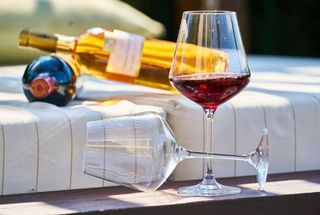How Is The Sweetness Of Wine Measured? An Expert Explains

Like so many elements in the fascinating world of wine, the concept of sweetness is often open to debate. For some connoisseurs, a wine may only be considered sweet if it falls among those categories boasting the highest levels of residual sugar, such as Tokaji and Passito wines. For others, wine is a decidedly 'dry' invention and talk of sweetness has no business here at all. As always, personal taste reigns supreme, so let's stick to the facts. We spoke to the Lukasz Kolodziejczyk, Head of Fine Wine at Cult Wines, to find out how the sweetness of wine is measured.
What makes a wine taste sweet?
Winemaking is an exact science, with every single component that goes into a wine - from yeast and preservatives to the grape variety itself - ultimately affecting the eventual flavour profile. And even then each wine will be experienced differently by different people, based on their unique sense of smell and saliva makeup. However, while levels of tannin, alcohol and acidity play a significant role in a wine's perceived sweetness, the biggest factor is residual sugar. It probably won't surprise you to learn that the more residual sugar there is in a wine, the sweeter it will be.
What is residual sugar?
Residual sugar (often abbreviated to RS) is the naturally occurring grape sugars left in a wine after the alcoholic fermentation process is completed. Dry wines will also often contain some level of RS - usually to help balance high acidity. It's measured in grams per litre, with 10 grams per litre of residual sugar giving a 1% sweetness level. An interesting titbit: the average wine drinker generally can't detect sweetness levels below 1.5%, whereas trained tasters can estimate sweetness within about 0.2%!
How sweet is my favourite style of wine?
There are generally accepted RS parameters for each category of sweetness (or dryness, depending on how you look at it), for both red and white wines. Again though, the exact numbers are often subject to debate depending on the region, grape and/or winemaker.
Whites
Dry - 0-2%
Muscadet, Sauvignon Blanc, Pinot Gris, Chardonnay, Chenin Blanc, Viognier.
Off-dry - 3-6%
Gewurztraminer, Riesling.
Sweet - 6%+
Moscato, white Port, ice wine.
Reds
Dry - 0-2%
Sangiovese, Tempranillo, Cabernet Sauvignon, Pinot Noir, Syrah, Merlot, Malbec, Zinfandel.
Medium sweet - 6-9%
Lambrusco Dolce.
Sweet - 10%+
Port, Tawny Port.
How are sweet wines made?
During alcoholic fermentation, yeast feeds on the sugar found in grape juice and converts it to ethyl alcohol, or ethanol, and carbon dioxide. The amount of sugar fermented determines the wine's alcohol level and the amount of residual sugar left in the wine. To produce off-dry or sweet wines, the winemaker will intentionally halt the fermentation process prematurely, usually by lowering the temperature - chilling the vat paralyses the yeast, preventing it from completing its 'job', thereby leaving residual sugar.
Dessert wines, meanwhile, are typically made from dried grapes which have a much higher sugar-to-juice concentration. Here, the yeast will gorge on the sugar and die off as the alcohol rises, still leaving behind extra sugar. Sweet Port is made in a third way, with fermentation paused halfway through production and a high-alcohol spirit added to kill the yeast, once again leaving behind natural grape sugar.
Is sugar ever manually added to wine?
In some cases, yes. Many sparkling wines and German Rieslings have a high acidity - and subsequently a very sharp taste - that can be balanced out with natural, unfermented grape juice. And during Champagne making, producers may adopt a step called 'liquer d'expedition', where they add a small amount of grape must or sugar before corking the bottle.
How can I find out how much residual sugar is in my wine?
The short answer is, you can't - not easily, anyway. Since wine isn't required to include nutrition information on its labelling, there's no reason for producers to add details about sugar content. With the exception of a few occasional instances, any sugar found in a wine - dry, sweet or otherwise - will usually be naturally occurring, and not at all like the sugar often mentioned in additive scare stories found in the news.
Monisha Gohil
Digital PR Executive
Cult Wines